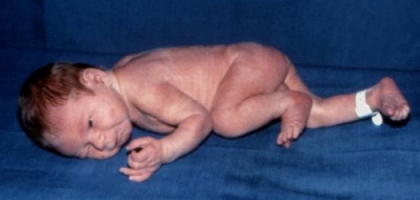During the newborn period infants are adapting to the new social and physical environment. The sensorimotor abilities they acquired while in the buoyant fluid intrauterine environment are harnessed and adapted to the new constraints on movement imposed by gravity and the surfaces they encounter. The limbs have weight and movement of the limbs produces reactive forces as well as momentum which need to be factored into the control of their movements.
Newborn infants when they are awake and alert and lying on a firm surface respond to visual and auditory events in the environment and actively engage in spontaneous movements of the limbs.
The looking, listening and moving provides opportunities for linking what they do to what is seen, heard and felt, creating the perception-action loops that are the basis for making the shift from spontaneous exploratory movements to intentional, goal directed actions that allow the infant to interact with people, things and events in their environment.
Newborn sensorimotor synergies
The newborn infant arrives in the extra-uterine world with numerous movement behaviours that support their survival, interaction with the environment and ability to learn from experience.
Movement behaviours present at birth are organised as sensorimotor synergies which can be adapted to changing circumstances and events in the environment.
Previously these sensorimotor symergies were described as reflexes, but more recent studies have shown that the synergies involve complex patterns of movements adapted to ongoing changes in the environment (von Hofsten 2018).
Rooting response
Rooting refers to the infant's tendency to turn the head towards a mechanical stimulus applied to the area around the mouth, which facilitates latching onto the nipple for feeding.
Traditionally rooting was considered to be a stereotyped response to a stimulus (reflex), however Odent (1979) showed that rooting does not just involve movements of the head and mouth but also exploratory movements of the whole body with all the senses involved.
Rooting is not elicited when the infant touches herself (Rochat & Hespos, 1999).
Sucking mechanism
“Skilled sucking relies on a complex interaction of muscle contractions that are prospective in nature. Within a day or so after birth the sucking system functions with amazing accuracy.
There are two phases of sucking, one that creates a temporary vacuum in the mouth region and one the releases the milk from the nipple. A well-functioning sucking action relies on adjusting the change in sucking pressure to the flow of milk that is different from suck to suck. In other words, the newborn infant has to sense the upcoming flow of milk and adjust the sucking pressure to it ahead of time.”
“Craig and Lee (1999) found that neonates adjusted their sucking action in a precise and prospective way indicating that they anticipated the upcoming flow of milk.” (Von Hofsten 2018)
Ability to lift and turn head to keep airway clear
When placed face down on a supporting surface newborn infants will lift and turn their heads to clear the airway. Lifting and turning the head involves not only the neck muscles, but also requires some adjustments in the UE and trunk muscles to provide some stability to support the neck movements.
Limb movement synergies at birth
The multi-segmented structure of the body provides the basis for producing the varied movement patterns seen in human actions. To simplify control of the many degrees of freedom inherent in a multi-segmented body, spontaneous infant movements are constrained and organised into synergies (von Hofsten, 1989).
During the neonatal period the lower extremity synergy is characterised by intralimb coupling of hip and knee flexion or extension. The upper limb synergy combines shoulder and elbow extension with extension of the fingers and wrist.

Over the first few months as the infant explores different ways of interacting with the environment and as the frontal motor areas become more active, the strong intralimb coupling lessens as movement are adapted to allow for effective interaction with the environment.
Behavioral states and movement
When awake infants shift between several different states which affect the organization of their spontaneous movements.
In an alert but quiet state movement is minimal. The alert but quiet state is often associated with visual attention to the infant's own hand or the face of a social partner and other interesting visual stimuli in the environment.

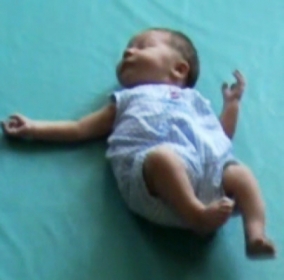
In the alert and active state infants engage in bouts of vigorous spontaneous movements of the limbs.
When distressed the infant's movements are ongoing and very vigorous. Jitters and trembling may be present in the limbs.
Head posture and movements
Generally the newborn's head is rotated to one side, often with a preference for a particular side. Neck rotation is associated with neck extension. This tendency to rest with the head rotated to one side is in part influenced by the round shape of the back of the head and weakness in the neck muscles (Bly 1994). However, using real time ultrasound, Ververs et al (1994) found that the development of head position involved a change from a midline to a lateralized preference. developing at 38 weeks with the he head being held mainly to the right.
Newborn infant also often have a preferred side, usually to the right (Ronquist et al 1998). The reason for this tendency is unclear.


A prominent feature of head rotation in the first two months is the tendency for rotation to be coupled with neck extension and lateral flexion to the opposite side, which is a reflection of the imbalance in activity between the sternocleidomastoid (SCM) muscles and deep neck flexor muscle activity (Bly 1994).
The infant is able to turn the head to the midline, and can sustain the position briefly, especially when supported by visual attention to an interesting person, object or event.
Typically the head is held in the mid-position for brief periods of time when the infant is actively moving the limbs or is distressed (Cornwell et al 1985). This is possibly due to increased activity in the neck and trunk muscles associated with the kicking actions.

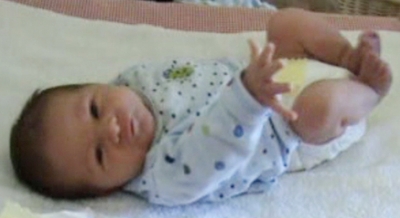
Over the next few weeks the infant will develop the the bilateral antigravity neck muscle strength and control needed to counteract the force of gravity (which creates a turning moment acting on the COG of the head) and maintain the head in midline for longer periods of time. (More about the development of head control)
Newborn rolling
In neonates with typical limb stiffness (muscle tone), head turning may initiate partial rolling to the side. This response may be due to the neonatal neck righting reflex (Bly 1994) but may also be because turning of the neck shifts the infants weight (COP) laterally which destabilizes the trunk and the infant "'topples" over to side lying.
The series of Will (6 days) rolling shows the complex interaction between movements of the head and limbs, along with changes in the COM and reactive forces produced by movements of the limbs, all of which contribute the the rolling action. This complex interactions is reminiscent of the fetus' whole body movements when turning in utero.
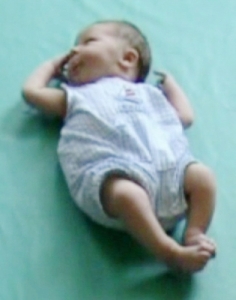
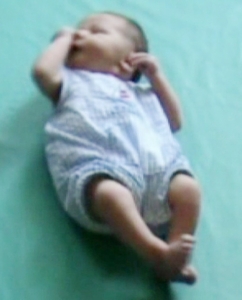
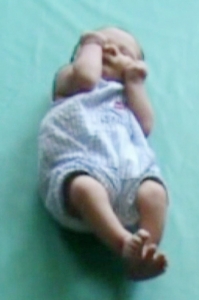
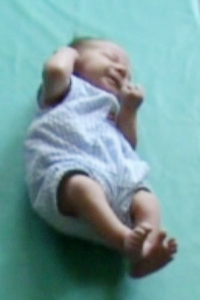

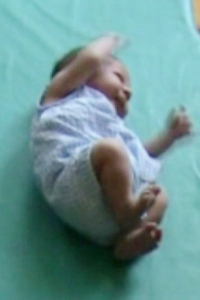

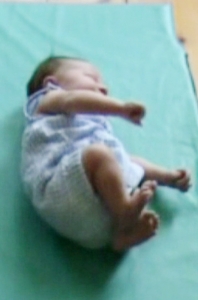
Visual attention
From the first weeks infants pay attention to interesting objects that come into their field of vision. Visual attention is usually associated with cessation of limb movements.
When the head is supported in the midline the newborn infant will look at the face of a caregiver for extended periods of time. Infants will turn the head away when they need a break from the intensity of this focussed social interaction.


When the head is supported the newborn can move the head to bring the social partner's face into the center of the visual field.
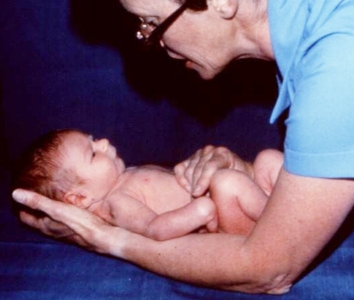
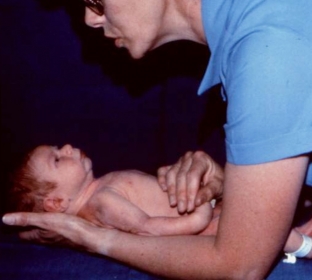
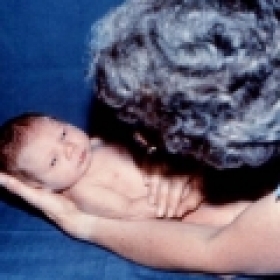
When paying attention to a social partner, the infant will mirror facial expressions and even stick out the tongue if this has been demonstrated.
Newborn infants engage in sustained visual regard of their own hands. Interestingly, they also pay close attention to the hands of a caregiver.
General movements
Extensive research has described the characteristics of the complex movements that involve the entire body observed in infants from 0-2 months. “These movement, referred to a writhing general movements, are characterized by a variable sequence of neck, arm, trunk, and leg movements. They wax and wane, varying in intensity, speed, and range of motion, and have a gradual onset and end. Rotations along the axis of the limbs and slight changes in the direction of movement make them appear fluent and elegant and create the impression of complexity and variability.” (Einspieler et al 2008).
A general movement assessment involves observing an alert and awake infant from a 3-5 minute video clip of the infant in supine. Poor quality GMs are classified using the following criteria:
- poor repertoire (low complexity and variability, monotony);
- cramped-synchronized (no smoothness, simultaneous contraction and relaxation of the limbs);
- chaotic (no smoothness, chaotic and abrupt movements of large amplitude) (Ferrari 2016).
Lower extremity posture, ROM and kicking actions
In infants born at term the range of movement (ROM) of the hips and knees is limited by muscle tightness and increased muscle tone (stiffness) in the lower extremity (LE) flexor muscles that result from the flexed posture in the restricted space in the uterus in the last weeks of intrauterine life. The restriction in hip extension is referred to as neonatal hip flexion contracture.
During periods of relative quietening of movement, the hips are flexed, abducted and laterally rotated and the infant lies with the feet lifted up off the supporting surface (SS). The knees cannot be fully extended and when passively extended they recoil back to a more flexed position.

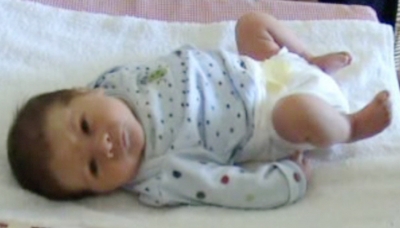
Newborn kicking actions are characterized by a decrease in the range of hip flexion, along with some extension of the knee. The ankle remains in dorsiflexion with the toes in flexion. This relative extension of the hip and knee is followed by a return to the more flexed resting position.
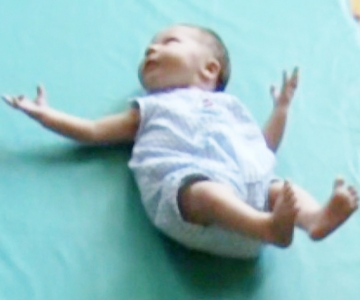

Upper extremity (UE) posture and movements
Bly (1994) states that when the newborn infant is lying quietly, the upper arms rest on the supporting surface close to the body, with the shoulders in slight external rotation, the elbows in flexion and with the hands slightly open.


Spontaneous movements of the UEs often bring the hand into the infant's visual field and a period of quiet may ensue as the infant pays attention to the hand.
Spontaneous movement of the UEs also brings the infant's hands into contact with the face. This is a familiar experience for the infant as hand-to-mouth is a common intrauterine movement pattern.
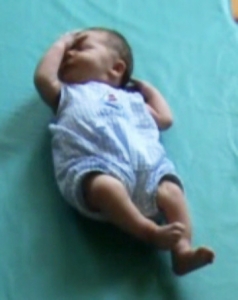

Large range movements of the shoulder and elbows are seen, with opening of the fingers when the elbow is extended and flexion of the fingers seen with elbow flexion (von Hofsten 1990).

Spontaneous movements of the fingers - initially mainly grasping and hand opening, but including with increasing frequency a variety of hand postures, including pointing with the forefinger, thumb to forefinger, simultaneous flexion of the forefinger and middle finger, as well as ring and little finger.
Below you see the most common finger movements observed in von Hofsten And Ronquist's 1994 study.

Not only do infants move their fingers individually, but a study by Nagy et al (2014) demonstrated that newborn infants are able to imitate a demonstration of one, two and three finger extension patterns
Strong finger flexion occurs when the hand is stimulated especially on the ulnar side – known as the palmer grasp response. When traction is applied to the arm, the fingers flex synergistically with the elbow and shoulder.

Prone
When placed in prone, the newborn lies with head turned to one side, the hips and knees flexed and the shoulders in adduction with the elbows flexed.
The infant is able to lift the head briefly and turn it to one side to free the airway.
Full flexion of the hips in prone lying is associated with posterior pelvic tilt and lumbar flexion. The body weight is distributed across the head, chest and LEs.
The UEs are held close to the torso with the shoulders in adduction, the elbows in flexion and the hands, and sometimes the forearms, resting on the SS.

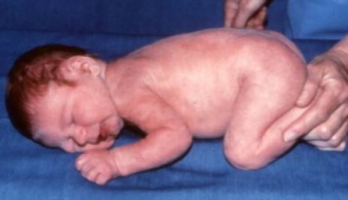
In the past many infants were put into prone for sleeping, but more recently because prone sleeping is a risk factor in sudden infant death, parents are advised to let infants sleep on their backs. As a result many infants do not like being placed in prone and very quickly learn to roll from prone to supine.
Sitting
When the newborn infant is supported in sitting, the neck and trunk are flexed, producing a C-shaped curve of the spine.
The newborn can usually lift the head briefly, but cannot sustain the position. However within a week or two they are able to lift the head and hold it erect for a short period in response to an interesting visual event.
The lower limbs are held in flexion, abduction, lateral rotation with flexion of the knees and dorsiflexion of the ankles.


Pull-to-sit
The pull-to-sit is maneuver often used when assessing infants. In newborn there is little effort to support the when the head and torso are lifted up by pulling on the hands. Once the trunk is upright, the infant makes an attempt to bring the head erect. (Read more about the development of PTS)

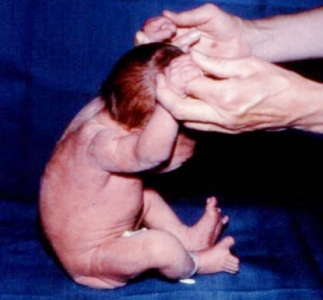
Return to
Newborn-3 months: Development and Assessment
Useful resources
Newborn exam: University of Utah https://library.med.utah.edu/pedineurologicexam/html/newborn_n.html
Perinatal Nursing Education Understanding the Behavior of Term Infants https://www.marchofdimes.org/nursing/modnemedia/othermedia/states.pdf (Accessed Nov 2018)
References and bibliography
Adolph, K.E. and Kretch, K.S. (2015) Gibson’s Theory of Perceptual Learning. International Encyclopedia of the Social & Behavioral Sciences, Second Edition
Bly L. (1994) Motor Skills Acquisition in the First Year.
Cornwell, K. S., Fitzgerald, H. E., & Harris, L. J. (1985). On the state‐dependent nature of infant head orientation. Infant Mental Health Journal, 6(3), 137-144.
Craig, C.M. and Lee, D.N. (1999) Neonatal control of sucking pressure: Evidence for an intrinsic tau-guide. Experimental Brain Research, 124, 371-382.
Duncan K, Goodworth A, Da Costa CSN, Wininger M, Saavedra S. (2017) Parent handling of typical infants varies segmentally across development of postural control. Exp Brain Res. 236(3):645-654.
Dusing, S. C., Thacker, L. R., Stergiou, N., & Galloway, J. C. (2013). Early Complexity Supports Development of Motor Behaviors in the First Months of Life. Developmental Psychobiology, 55(4), 404–414.
Dunsirn S, Smyser C, Liao S, Inder T, Pineda R. (2016 ) Defining the nature and implications of head turn preference in the preterm infant. Early Hum Dev. May;96:53-60.
Einspieler, C., Marschik, P. B., & Prechtl, H. F. R. (2008). Human Motor Behavior Prenatal Origin and Early Postnatal Development. Journal of Psychology, 216(3) 148–154.
Griffith, T., Rankin, K., & White-Traut, R. (2017). The Relationship Between Behavioral States and Oral Feeding Efficiency in Preterm Infants. Advances in neonatal care : official journal of the National Association of Neonatal Nurses, 17(1), E12-E19.
Lau, C. (2015). Development of Suck and Swallow Mechanisms in Infants. Annals of nutrition & metabolism, 66 Suppl 5(0 5), 7-14.
Lee HM, Galloway JC. (20120 Early intensive postural and movement training advances head control in very young infants. Phys Ther. Jul;92(7):935-47.
Lima-Alvarez CD, Tudella E, van der Kamp J, Savelsbergh GJ. (2013) Effects of postural manipulations on head movements from birth to 4 months of age. J Mot Behav. 45(3):195-203.
The authors investigated the effects of postural manipulation on head movement control in infants from birth to 4 months of age. Eighteen full-term infants were presented with a card, which was moved from side to side before their eyes in 3 positions: unsupported supine, supported supine, and supported reclined. The results showed a higher proportion of initial position of head at midline and midline-to-side trajectory, improving the alignment of head and trunk; fewer movement units and movement units after peak velocity; lower mean angular velocity and peak velocity; and a broader rotation of the head in both supported positions. Thus, external support of the head promoted head and trunk alignment, improving stability and enabling the infant to execute better-controlled head movements. These findings may be helpful in early intervention and treatment of at-risk infants.
Lima-Alvarez CD, Tudella E, van der Kamp J, Savelsbergh GJ. (2014) Early development of head movements between birth and 4 months of age: a longitudinal study. J Mot Behav. 46(6):415-22.
Nagy E, Pal A, Orvos H. (2014) Learning to imitate individual finger movements by the human neonate. Dev Sci. 17(6):841-57.
Reddy, V., Markova, G., & Wallot, S. (2013). Anticipatory Adjustments to Being Picked Up in Infancy. PLoS ONE, 8(6), https://www.ncbi.nlm.nih.gov/pmc/articles/PMC3688725/
Rönnqvist L, Hopkins B. (1998) Head position preference in the human newborn: a new look. Child Dev. 69(1):13-23. PubMed PMID: 9499553.
Head position preference was studied in 20 awake newborns who differed in terms of delivery and sex. They were placed supine on a custom-built platform to reduce the effects of gravity and asymmetries in trunk posture and skull shape. A global and a specific scoring method were used, the infants being in State 3 (quiet wakefulness) or 4 (active wakefulness, excluding crying). Delivery and sex did not account for differences in head position. The head turned more often to the right and was maintained longer in this position during State 3, regardless of scoring method. The maintenance of the head in midline was comparable in duration to that reported for infants at 2-3 months when using the global scoring method. This suggests that the neural mechanisms responsible for attaining and maintaining a midline position are present at birth, but are not functionally expressed due to a lack of adequate power in the antigravity muscles of the neck.
Van der Meer, a L. (1997). Keeping the arm in the limelight: advanced visual control of arm movements in neonates. European Journal of Paediatric Neurology : EJPN : Official Journal of the European Paediatric Neurology Society, 1(4), 103–8. Retrieved from http://www.ncbi.nlm.nih.gov/pubmed/10728203
Ververs IA, de Vries JI, van Geijn HP, Hopkins B. (1994) Prenatal head position from 12-38 weeks. I. Developmental aspects. Early Hum Dev. 28;39(2):83-91.
Fetal head position relative to the fetal body was studied longitudinally in 10 uncomplicated pregnancies by means of real-time ultrasound. Registrations were made at 4 weekly intervals from 12 to 36 weeks, and at 38 weeks. The percentage of assessments with optimal visualization of head position for analysis increased with age. The development of head position involved a change from a midline to a lateralized preference. It was only at 38 weeks that a clear lateralized head position was found with the head being held mainly to the right. The degree of intra- and inter-individual variability was considerable, a finding typical of motor behaviour in the healthy fetus. It is hypothesized that this bias is due to neural maturation. The implications of our findings for the subsequent development of hand preferenceare discussed.
von Hofsten C, Rönnqvist L. (1993) The structuring of neonatal arm movements. Child Dev. 64(4):1046-57. PDF
Van der Meer, a L. (1997). Keeping the arm in the limelight: advanced visual control of arm movements in neonates. European Journal of Paediatric Neurology : EJPN : Official Journal of the European Paediatric Neurology Society, 1(4), 103–8.
To test whether newborn babies have voluntary control over their limbs, spontaneous arm-waving movements were measured in the dark while the baby lay supine with its head turned to one side. A narrow beam of light was shone over the baby's nose or chest in such a way that the arm the baby was facing was only visible when the hand encountered the, otherwise, invisible beam of light. The results showed the babies were capable of precisely controlling the position, velocity, and deceleration of their arms so as to keep the hand visible in the light. The findings indicate that newborns can purposely control their arm movements to meet external demands and that the development of visual control of arm movement is underway soon after birth
Ververs IA, de Vries JI, van Geijn HP, Hopkins B. Prenatal head position from 12-38 weeks. I. Developmental aspects. Early Hum Dev. 1994 Oct 28;39(2):83-91.
Fetal head position relative to the fetal body was studied longitudinally in 10 uncomplicated pregnancies by means of real-time ultrasound. Registrations were made at 4 weekly intervals from 12 to 36 weeks, and at 38 weeks. The percentage of assessments with optimal visualization of head position for analysis increased with age. The development of head position involved a change from a midline to a lateralized preference. It was only at 38 weeks that a clear lateralized head position was found with the head being held mainly to the right. The degree of intra- and inter-individual variability was considerable, a finding typical of motor behaviour in the healthy fetus. It is hypothesized that this bias is due to neural maturation. The implications of our findings for the subsequent development of hand preferenceare discussed.
von Hofsten C, Rönnqvist L.(1993) The structuring of neonatal arm movements. Child Dev. ;64(4):1046-57. PDF
von Hofsten C, Rosander K. (2018) The Development of Sensorimotor Intelligence in Infants. Adv Child Dev Behav. 55:73-106.
Von Hoften, C, Ronquis L. (1994) Neonatal finger and arm movements as determined by a social context. Early Development and Parenting . 3(2), 81-94
